Hi Sweat Fam!
Anna here! Today I’ll be talking briefly about hip mobility. I say ‘briefly’ because the hip complex is extremely, well, complex. There are entire books written about the functionality and anatomy of the hips, but today, I’ll just go over the basics and why you should be concerned about your hips.
If you’ve been in my yoga class, you’ve probably come to expect pigeon or some variation of it, in addition to several other hip stretches, as well as strength building postures like chair, goddess or any of the warrior postures. I try to teach to the bodies in the room, meaning I think about what you do during the day and which postures benefit you most. Most people spend a considerable amount of time sitting, which impacts our hips in two ways. First, it shortens the psoas, which is a small muscle on the front of the hip (what most people think of as the hip flexor). Second, prolonged, sustained sitting weakens the glute muscles. The act of sitting itself doesn’t weaken the glutes, but rather the lack of muscle activation over a long period contributes to weakness. This leaves us with muscular imbalance and can contribute to, in the short term, low back pain and general discomfort, or, in the long term, increased risk for falls, breaks and other injuries.
A second issue is the lack of variety in movement relative to the hips. Most people predominately move in what is termed the sagittal plane, meaning front-to-back movement (think walking, bicep curls or a standing leg raise). However, the hip complex also consists of muscles that support lateral (side-to-side) movement and transverse (twisting) movement. When movement variety is lacking, the stabilizing muscles that activate lateral and transverse movement are at a disadvantage. These are the muscles that contribute to internal and external hip rotation or side or lateral lifting of the leg. In the short term, this leads to a muscular imbalance, aches, and pains. In the long term, it decreases stability while increasing risk for falls, especially in older populations.
What can you do to combat hip issues? The solution isn’t all that complicated! First, start by alternating between standing and sitting throughout the day. Try a ratio of 40:20, meaning, sit for 40 minutes and stand for 20. Second, Make sure you include strength and flexibility training in your workout program. Step out of your exercise comfort zone to move your body in different planes of motion. If you haven’t been to one of our HIIT, Barre or Pilates classes, they’re a great way to change things up. I went to my first Barre class last week and, let me tell you, I worked my glutes like never before! Our Power Yoga classes also focus on proper alignment with strength building. Third, if you feel like something is wrong with your hips, visit your health care provider. They can refer you to the right person to treat your issues. As fitness professionals, we don’t diagnose or prescribe any medical treatment. We are happy to work in conjunction with a health care team, but it’s important that you address any injuries or concerns with a doctor before taking on a fitness program. As always, listen to your body during class. You know best when something doesn’t feel right and should modify accordingly.
If the topics of anatomy and movement relative to fitness interest you, Lauren and I will be hosting a workshop on February 18 where we dive deeper into exercise science. We’ll discuss proper core activation, functional movement of all muscle groups, how to design your own workouts at home, and lots, lots more! It’s only $35 to attend and is a great introduction for anyone interested in teaching HIIT or Pilates at Sweat!
Namaste,
Anna Moore
